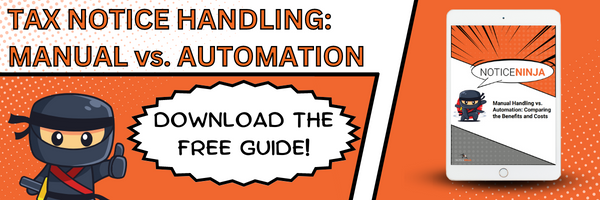Yes, NOTICENINJA is corporate tax notice compliance software that automates key workflows including notice assignments. The platform employs a rule-based system that can manage multiple level rules and ensure notices are directed to the appropriate stakeholder. As a result, you’ll never have to worry about notices being misdirected or slipping between the cracks.
.png)
9 Common Mistakes to Avoid with Your Tax Notices

01 March
If you've ever received a notice from the IRS, your initial reaction may understandably be to panic. However, there is no need to fret. The IRS commonly sends out notices to taxpayers for many reasons. You may have received a letter about a specific issue on your federal tax return, changes to your account, a request for more information, or a payment request.

While these letters can be confusing and redundant, you can resolve or prevent most issues without visiting or calling an IRS office. We've compiled a list of the nine most common IRS notice mistakes to help you navigate the process.
Ignoring or Delaying Response
Your notice or letter will indicate a specific response date, so you'll want to reply promptly. Many agencies will send notices every seven days until they receive a response. The three main reasons you don't want to ignore or delay your response by doing the following:
- Minimizing any additional interest accruing
- Avoiding penalty charges for late payments
- Not missing the appeal deadline if you want to dispute your notice
The IRS notice will specify your reply options, which include mail, fax, or online.
Misplacing the Notice in the Office
You'd be surprised how easily an IRS notice can get buried under a stack of other documents. Avoid losing your notices by responding to them quickly or making a record of them in your internal system.
Noting it Incorrectly in a Spreadsheet
The larger your company gets, the more IRS notices you'll receive, simply due to the increased personnel and business you conduct. Many business owners keep their notices organized by creating a spreadsheet, which has limitations, especially as volume increases. Double-check your data entry when you log new IRS notices to avoid any errors or mistakes, making sure to type all numbers and dates correctly.
However, you could eliminate this issue by using an automated filing system. These will scan documents, input numbers directly, and alert the necessary person to the notice.
Providing Inaccurate Documentation
Sending the IRS incorrect information is an incredibly common mistake due to the tax process complexity. Improper documentation can misrepresent the amount of revenue you make, leading to either under or overcharging for your taxes.
You can resolve this by disputing the claim and providing the correct documentation, which can take extra time, incur penalties, and cost legal fees while sorting it out. Make sure you verify the documents you send are current and for the correct jurisdiction.
Not Following Correct Payment Procedures
If your IRS notice requires a payment, make sure the payment amount you remit matches the notice. Incorrect payment amounts can cause the IRS to issue you a late payment notice, which will likely incur additional fees until you pay the difference.
Each agency has different limits and requirements when making payments and filing returns—some require electronic filing once reaching certain thresholds. You can avoid this mistake by carefully reading your notice and following payment instructions.
Failing to Keep Accurate Records
The IRS does not make exceptions for employers who are unable to keep accurate records. All businesses must keep track of their data entries, ensuring everything is correct and up to date. Inaccurate records make filing taxes challenging, leading to receiving audit requests to determine accuracy. The burden of proof is on the employer.
Non-Compliance with Payroll Tax Laws
Failing to comply with payroll tax laws can incur fees and could even result in jail time. Laws often change or get updated -- make sure you stay up to date with the laws in all the states where you have a filing requirement. Ignorance of the law is not a valid excuse the IRS will accept.
Not Consulting with Professionals for Help
When IRS notices become too overwhelming, there is nothing wrong with requesting professional help. Tax laws are complicated, and consulting with advisors will help you file accurately. When you notice requests for any amount over $100,000, it's time to ask for assistance. Making a mistake with any high fine could lead to more unwanted issues, but a tax professional can help you navigate this and confer with the IRS to mitigate future penalties.
Manually Logging All Notices
Manually logging notices often leads to inaccuracies and miscommunications, which can accidentally cause non-compliance. If you own a large company, performing quality control in every department can be difficult. A mistake could easily slip through the cracks if you aren't double-checking manually entered notices.
The other drawback to manual logs is that they're difficult to share easily with your staff. Typically, only one or a few people can access these logs, making it challenging for everyone who needs to access these notice logs to know what they need to do.
How to Organize All IRS Notices
Many mistakes with IRS notices stem from disorganization, which is also true for notices from state and local agencies. If you have a messy system, notices will more likely get lost or have a late response, which can create further issues down the line. However, organizing your tax notices does not need to be challenging, especially in this age of technology.
Strides with automation software are making it easier than ever to keep your notices organized, as they scan documents, share them with the necessary people, and create an accessible, transparent record of what notices you receive. That will let you know which notices require responses and which are reminders or updates.
That is where NOTICENINJA comes in. Our automation software has been at the forefront of the notice compliance industry, using automated software solutions to help companies stay on top of their IRS notices. Never miss an IRS notice deadline or payment again. Contact us today to get started on organizing all your IRS notices and letters.

